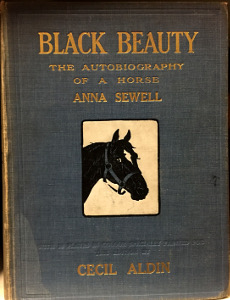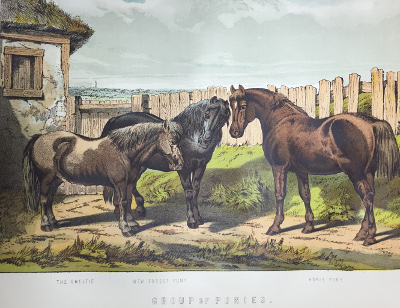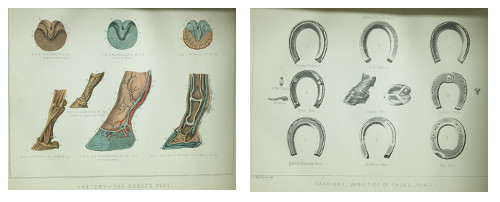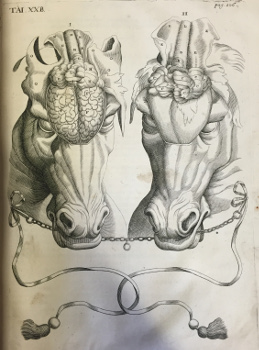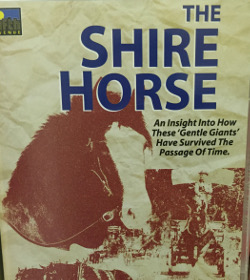Written by Louise Cowan, Trainee Liaison Librarian
Unsurprisingly, the Special Collections and Museum of English Rural Life Libraries have a number of items relating horses; from journals to artwork, rare books and DVDs. Here are just a few of my favourites:
Horses in Fiction:
Black Beauty – Anna Sewell, illustrated by Cecil Aldin (1912) [Children’s Collection 823.8 SEW]
The Special Collections library holds a number of editions of Anna Sewell’s horse autobiography, ‘Black Beauty’. Originally published in 1877, it tells the story of the titular horse, from his early days growing up on a farm with his mother, to the hardships he suffered pulling cabs in London. The story advocates fairer and kinder treatment of horses and has been described as “the most influential anticruelty novel of all time.” (Unti, 1998)
This edition was published in 1912 and contains a number of beautiful illustrations by British artist and illustrator Cecil Aldin.
Unti, Bernard (1998). “Sewll, Anna”. In Bekoff, Marc. Encyclopedia of Animal Rights and Animal Welfare. Greenwood Press. p. 313.
Horse History and Care:
Modern Practical Farriery, A Complete System of the Veterinary Art – W.J. Miles c.1870 [MERL Reserve FOLIO 4340 MIL]
This wonderful book provides a holistic guide to horses; including their history, anatomy and medical care.
In an attempt to uncover their place of origin, Miles explores the history of the horse from Biblical times to the reign of Alfred the Great. He notes that psalmist David, “speaks with proud distain of horses as used in war,” and that in the era of Solomon a horse would set you back 150 shekels or £17 10s (roughly £800 in today’s money) an immense sum for the time. Having traced the horses ancestry to Africa and Eastern and Northern Asia, Miles goes on to discuss the natural history of the animal, looking at horses from all around the world, including wild horses, those of Persia, India and Arabia.
The books gives detailed advice on how to train, ride, race, buy and look after the health and wellbeing of a horse. Unsurprisingly, considering the title of the book, a large section is devoted to ‘shoeing’. It notes the interesting idea that Roman Emperor Nero had his horses shod with silver while his wife Poppea shod her mules with gold! There are also a number of careful diagrams, showing the tools of the farriery trade and the different types of shoe: such as the ‘Pointed Shoe’ supposed to bring comfort to all horses and horsemen (though Miles doesn’t seem convinced) and the ‘Bar Shoe’ useful for horses with poorly feet.
Horses in Science:
The Anatomy of an Horse by Andrew Snape, 1683 [Cole 092F/15]
This comprehensive and beautifully illustrated book was written by Andrew Snape (1644-1708) who was one of the farriers to King Charles II. One of the most comprehensive books of its type, (U.S. National Library of Health) it contains five chapters describing the anatomy of different parts of the horse including; the lowest belly or paunch, the middle venter or chest, the uppermost venter or head, the muscles of the body and the bones.
Snape begins by defining anatomy as ‘an opening or cutting up of the body of any animal or living creature whatsoever, whether frequenting the land or water, whereby the knowledge of the frame of its body, and the use of its parts may be attained unto.’ He then goes on to describe each of the parts from the outside in. His description of the brain is particularly interesting; he describes it as being split into two parts; the brain (at the front and consisting of the cortex) and the after-brain (at the back and divided into four parts one of which is called ‘Worm-like processes’ as it looks like the worms found in rotten timber).
The action of the brain is to elaborate the Animal Spirits, which from it are transmitted to the Medulla oblongata, and from thence into the Nerves, for the sensation and motion of the whole body.
The brain he declares to be “one of the most noble parts of the whole body ranked for its dignity even with the Heart itself.” And points out how “absurd and ridiculous a thing it [is]then for any man that hath any brain himself, to imagine a Horse to have none? Yet such men I have my self met withal.”
Although the illustrations included in ‘The Anatomy of an Horse’ are spectacular, they are not entirely original as they appeared first in Carlo Ruini’s Anatomia (1598) (Peter Harrington) and a number can also be found in our copy of ‘la parfait cavalier ov la vraye connoissance dv cheval ses maladies et remedes’ by J. Jourdin, C. Ruini and L. Chamhoudry which was published 28 years earlier in France in 1655 [Cole 092F/20]
Horses on DVD!
The Shire Horse – Fifth Avenue [MERL Library]
A comprehensive look at the history of the Shire horse in Britain, from the animal’s introduction by William the Conqueror in 1066, to their role in the First World War and near extinction with the rise of the combustion engine in 1960s. A thoughtful and informative documentary with particular insights from Mr Roy Bird MBE and The Shire Horse Society.


